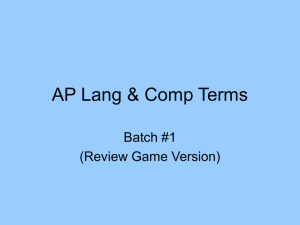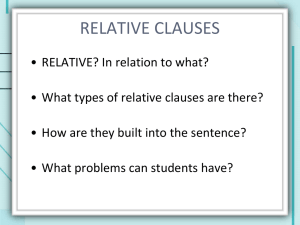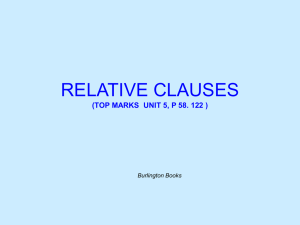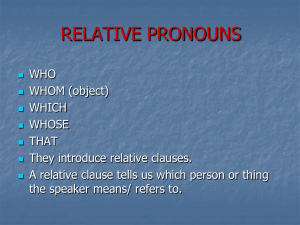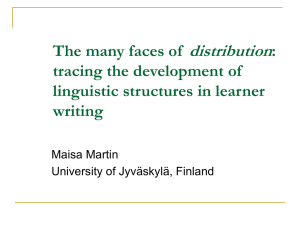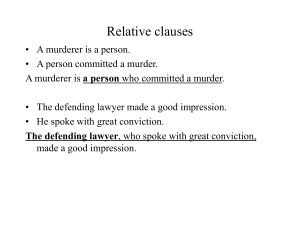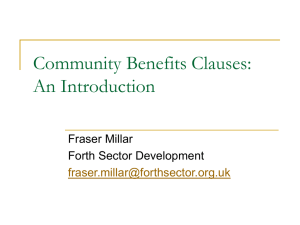A Simple, Greedy Approximation Algorithm for MAX SAT
advertisement
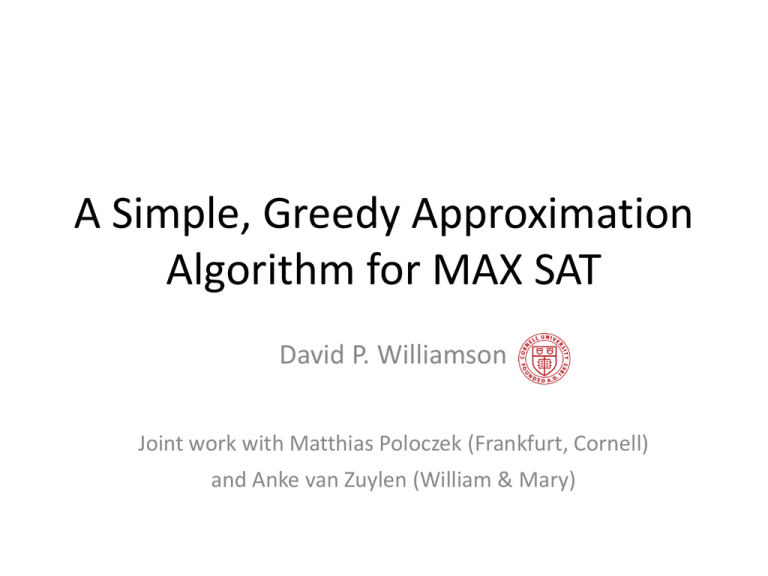
A Simple, Greedy Approximation Algorithm for MAX SAT David P. Williamson Joint work with Matthias Poloczek (Frankfurt, Cornell) and Anke van Zuylen (William & Mary) Greedy algorithms “Greed, for lack of awork.” better –word, good. Greed “Greedy algorithms Alan is Hoffman, IBM is right. Greed works.” – Gordon Gekko, Wall Street Another reason • When I interviewed at Watson, half of my talk was about maximum satisfiability, the other half about the max cut SDP result. • I thought, “Oh no, I have to talk about – Hardness of approximation in front of Madhu Sudan, – Randomized rounding in front of Prabhakar Raghavan, – And eigenvalue bounds in front of Alan Hoffman.” • Today I revisit the first part of that talk. Maximum Satisfiability • Input: 𝑛 Boolean variables 𝑥1, … , 𝑥𝑛 𝑚 clauses 𝐶1, … , 𝐶𝑚 with weights 𝑤𝑗 0 – each clause is a disjunction of literals, e.g. 𝐶1 = 𝑥1 𝑥2 𝑥 3 • Goal: truth assignment to the variables that maximizes the weight of the satisfied clauses Approximation Algorithms • An α-approximation algorithm runs in polynomial time and returns a solution of at least α times the optimal. • For a randomized algorithm, we ask that the expected value is at least α times the optimal. A ½-approximation algorithm • Set each 𝑥𝑖 to true with probability ½. • Then if 𝑙𝑗 is the number of literals in clause 𝑗 What about a deterministic algorithm? • Use the method of conditional expectations (Erdős and Selfridge ‘73, Spencer ‘87) • If 𝐸 𝑊 𝑥1 ← 𝑡𝑟𝑢𝑒 ≥ 𝐸 𝑊 𝑥1 ← 𝑓𝑎𝑙𝑠𝑒 then set 𝑥1 true, otherwise false. • Similarly, if 𝑋𝑖−1 is event of how first 𝑖 − 1 variables are set, then if 𝐸 𝑊 𝑋𝑖−1 , 𝑥𝑖 ← 𝑡𝑟𝑢𝑒 ≥ 𝐸 𝑊 𝑋𝑖−1, 𝑥𝑖 ← 𝑓𝑎𝑙𝑠𝑒 , set 𝑥𝑖 true. 1 2 • Show inductively that 𝐸[𝑊|𝑋𝑖 ] ≥ 𝐸 𝑊 ≥ OPT. An LP relaxation Randomized rounding Pick any function 𝑓such that 1 − 4−𝑥 ≤ 𝑓 𝑥 ≤ 4𝑥−1 . Set 𝑥𝑖 true with probability 𝑓(𝑦𝑖∗ ), where 𝑦 ∗ is an optimal LP solution. Analysis Integrality gap The result is tight since LP solution 𝑧1 = 𝑧2 = 𝑧3 = 𝑧4 = 1 1 and 𝑦1 = 𝑦2 = feasible for instance above, but OPT = 3. 2 Current status • NP-hard to approximate better than 0.875 (Håstad ’01) • Combinatorial approximation algorithms – Johnson’s algorithm (1974): Simple ½-approximation algorithm (Greedy version of the randomized algorithm) – Improved analysis of Johnson’s algorithm: 2/3-approx. guarantee [Chen-Friesen-Zheng ’99, Engebretsen ’04] – Randomizing variable order improves guarantee slightly [Costello-Shapira-Tetali ’11] • Algorithms using Linear or Semidefinite Programming – Yannakakis ’94, Goemans-W ’94: ¾-approximation algorithms Question [W ’98]: Is it possible to obtain a 3/4-approximation – Best guarantee 0.7969 [Avidor-Berkovitch-Zwick ’05] algorithm without solving a linear program? (Selected) recent results • Poloczek-Schnitger ’11: – “randomized Johnson” – combinatorial ¾approximation algorithm • Van Zuylen ’11: – Simplification of “randomized Johnson” probabilities and analysis – Derandomization using Linear Programming • Buchbinder, Feldman, Naor, and Schwartz ’12: – Another ¾-approximation algorithm for MAX SAT as a special case of submodular function maximization – We show MAX SAT alg is equivalent to van Zuylen ‘11. (Selected) recent results • Poloczek-Schnitger’11 • Van Zuylen ’11 • Buchbinder, Feldman, Naor and Schwartz ’12 Common properties: • iteratively set the variables in an “online” fashion, • the probability of setting 𝑥𝑖 to true depends on clauses containing 𝑥𝑖 or 𝑥𝑖 that are still undecided. Today • Give “textbook” version of Buchbinder et al.’s algorithm with an even simpler analysis Buchbinder et al.’s approach • Keep two bounds on the solution – Lower bound LB = weight of clauses already satisfied – Upper bound UB = weight of clauses not yet unsatisfied • Greedy can focus on two things: – maximize LB, – maximize UB, but either choice has bad examples… • Key idea: make choices to increase B = ½ (LB+UB) LB0 (= 0) B0= ½(LB0+UB0) UB0 (=∑wj) Weight of undecided clauses satisfied by 𝑥1= true LB0 LB1 Weight of undecided clauses unsatisfied by 𝑥1= true B0= ½(LB0+UB0) Set 𝑥1 to true UB1 UB0 Weight of undecided clauses satisfied by 𝑥1= true B1 LB0 LB1 B0 Set 𝑥1 to true Weight of undecided clauses unsatisfied by 𝑥1= true UB1 UB0 Weight of undecided clauses satisfied by 𝑥1= true B1 LB0 LB1 LB1 Set 𝑥1 to true or Set 𝑥1 to false B0 Weight of undecided clauses unsatisfied by 𝑥1= true UB1 UB1 UB0 Weight of undecided clauses satisfied by 𝑥1= true B1 LB0 LB1 LB1 Set 𝑥1 to true or Set 𝑥1 to false Weight of undecided clauses unsatisfied by 𝑥1= true B1 B0 UB1 UB1 UB0 Guaranteed that (B1-B0)+(B1-B0) ≥ 0 t1 f1 Remark: This is the algorithm proposed independently by BFNS’12 and vZ’11 Weight of undecided clauses satisfied by 𝑥𝑖= true LBi-1 Bi Bi LBi LBi UBi UBi UBi-1 Bi-1 Algorithm: • if 𝑡𝑖 < 0, set 𝑥𝑖 to false • if 𝑓𝑖 < 0, set 𝑥𝑖 to true • else, set 𝑥𝑖 to true with 𝑡𝑖 probability 𝑡𝑖+𝑓𝑖 Weight of undecided clauses unsatisfied by 𝑥𝑖 = true (Bi-Bi-1)+(Bi-Bi-1) ≥ 0 ti fi Example Clause Initalize: • LB = 0 • UB = 6 Step 1: • • 1 𝑡1 = 2 1 𝑓1 = 2 Weight 𝑥1 𝑥1 ∨ 𝑥2 𝑥2 ∨ 𝑥3 △ 𝐿𝐵 +△ 𝑈𝐵 △ 𝐿𝐵 +△ 𝑈𝐵 • Set x1 to false 1 = 2 1 = 2 2 1 3 1 + (−2) = 2+0 =1 1 − 2 Example Clause 𝑥1 𝑥1 ∨ 𝑥2 𝑥2 ∨ 𝑥3 Step 2: • • 1 𝑡2 = 2 1 𝑓2 = 2 Weight △ 𝐿𝐵 +△ 𝑈𝐵 △ 𝐿𝐵 +△ 𝑈𝐵 1 = 2 1 = 2 1+0 = 2 1 3 1 2 3 + (−1) = 1 • Set x2 to true with probability 1/3 and to false with probability 2/3 Example Clause Weight 𝑥1 𝑥1 ∨ 𝑥2 𝑥2 ∨ 𝑥3 Algorithm’s solution: 𝑥1 = false 𝑥2 = true w.p. 1/3 and false w.p. 2/3 𝑥3 = true Expected weight of 1 satisfied clauses: 5 3 2 1 3 Different Languages • Bill, Baruch, and I would say: Let 𝐺 be a graph... • Alan would say: Let 𝐴 be a matrix... And we would be talking about the same thing! Relating Algorithm to Optimum Let 𝑥1∗ , 𝑥2∗ , … , 𝑥𝑛∗ be an optimal truth assignment Let 𝑂𝑃𝑇𝑖 = weight of clauses satisfied if setting 𝑥1 , … , 𝑥𝑖 as the algorithm does, and 𝑥𝑖+1 = ∗ 𝑥𝑖+1 , … , 𝑥𝑛 = 𝑥𝑛∗ Key Lemma: 𝐸 𝐵𝑖 − 𝐵𝑖−1 ≥ 𝐸[𝑂𝑃𝑇𝑖−1 − 𝑂𝑃𝑇𝑖 ] Let 𝑥1∗ , 𝑥2∗ , … , 𝑥𝑛∗ OPT an optimal truth assignment LB Let 0 𝑂𝑃𝑇𝑖 = B0 B1 satisfied if setting weight of clauses OPT1 𝑥1 , … , 𝑥𝑛 as the algorithm does, and 𝑥𝑖+1 = ∗ 𝑥𝑖+1 , … , 𝑥𝑛 = 𝑥𝑛∗ Key Lemma: 𝐸 𝐵𝑖 − 𝐵𝑖−1 ≥ 𝐸[𝑂𝑃𝑇𝑖−1 − 𝑂𝑃𝑇𝑖 ] UB0 OPTn = Bn = weight of ALG’s solution Let an optimal truth assignment OPT LB Let 0 B1 UB0 = weight of clauses Bsatisfied if setting OPT as the 0 1 algorithm does, and B0 ≥ ½ OPT ≥ ½ (OPT-B0) Key Lemma: Conclusion: expected weight of ALG’s solution is 1 1 3 𝐸 𝐵𝑛 ≥ 𝐵0 + 𝑂𝑃𝑇 − 𝐵0 = 𝑂𝑃𝑇 + 𝐵0 ≥ 𝑂𝑃𝑇 2 2 4 Relating Algorithm to Optimum Weight of undecided clauses satisfied by 𝑥𝑖= true LBi-1 LBi LBi Bi Bi Bi-1 Weight of undecided clauses unsatisfied by 𝑥𝑖 = true UBi UBi UBi-1 ∗ Suppose 𝑥𝑖 = true Want to show: If algorithm sets 𝑥𝑖 to true, Key Lemma: • 𝐵𝑖 − 𝐵𝑖−1 = 𝑡𝑖 𝐸 𝐵𝑖 − 𝐵𝑖−1 ≥ 𝐸[𝑂𝑃𝑇𝑖−1 − 𝑂𝑃𝑇𝑖 ] • 𝑂𝑃𝑇𝑖−1 − 𝑂𝑃𝑇𝑖 = 0 If algorithm sets 𝑥𝑖 to false, • 𝐵𝑖 − 𝐵𝑖−1 = 𝑓𝑖 • 𝑂𝑃𝑇𝑖−1 − 𝑂𝑃𝑇𝑖 ≤ 𝐿𝐵𝑖 − 𝐿𝐵𝑖−1 + 𝑈𝐵𝑖 − 𝑈𝐵𝑖−1 = 2 𝐵𝑖 − 𝐵𝑖−1 = 2𝑡𝑖 Relating Algorithm to Optimum Want to show: Key Lemma: 𝐸 𝐵𝑖 − 𝐵𝑖−1 ≥ 𝐸[𝑂𝑃𝑇𝑖−1 − 𝑂𝑃𝑇𝑖 ] Know: If algorithm sets 𝑥𝑖 • 𝐵𝑖 − 𝐵𝑖−1 = 𝑡𝑖 • 𝑂𝑃𝑇𝑖−1 − 𝑂𝑃𝑇𝑖 If algorithm sets 𝑥𝑖 • 𝐵𝑖 − 𝐵𝑖−1 = 𝑓𝑖 • 𝑂𝑃𝑇𝑖−1 − 𝑂𝑃𝑇𝑖 to true, =0 to false, ≤ 2𝑡𝑖 Case 1: 𝑓𝑖 < 0 (algorithm sets 𝑥𝑖 to true): 𝐸 𝐵𝑖 − 𝐵𝑖−1 = 𝑡𝑖 > 0 = 𝐸 𝑂𝑃𝑇𝑖−1 − 𝑂𝑃𝑇𝑖 Case 2: 𝑡𝑖 < 0 (algorithm sets 𝑥𝑖 to false): 𝐸 𝐵𝑖 − 𝐵𝑖−1 = 𝑓𝑖 > 0 > 2𝑡𝑖 ≥ 𝐸 𝑂𝑃𝑇𝑖−1 − 𝑂𝑃𝑇𝑖 Relating Algorithm to Optimum Want to show: Key Lemma: 𝐸 𝐵𝑖 − 𝐵𝑖−1 ≥ 𝐸[𝑂𝑃𝑇𝑖−1 − 𝑂𝑃𝑇𝑖 ] Know: If algorithm sets 𝑥𝑖 • 𝐵𝑖 − 𝐵𝑖−1 = 𝑡𝑖 • 𝑂𝑃𝑇𝑖−1 − 𝑂𝑃𝑇𝑖 If algorithm Equal to sets 𝑥𝑖 • −𝐵𝑖𝑓− = 𝑓𝑖 2𝐵𝑖−1 𝑓 (𝑡 𝑖 𝑖 ) +2𝑡 𝑖 𝑖 • 𝑂𝑃𝑇𝑖−1 − 𝑂𝑃𝑇𝑖 Case 3: 𝑡𝑖 ≥ 0, 𝑓𝑖 ≥ 0 (algorithm sets 𝑥𝑖 to true w.p. 𝑡𝑖 𝐸 𝐵𝑖 − 𝐵𝑖−1 = 𝑡𝑖 𝑡𝑖 𝑡𝑖 +𝑓𝑖 + 𝑓𝑖 𝑓𝑖 𝑡𝑖 +𝑓𝑖 = 1 (𝑡𝑖 2 𝑡𝑖 +𝑓𝑖 to true, =0 to false, ≤ 2𝑡𝑖 𝑡𝑖 +𝑓𝑖 ): + 𝑓𝑖 2) 𝑡𝑖 𝑓𝑖 1 𝐸 𝑂𝑃𝑇𝑖−1 − 𝑂𝑃𝑇𝑖 ≤ 0 + 2𝑡𝑖 = (2𝑡𝑖 𝑓𝑖 ) 𝑡𝑖 + 𝑓𝑖 𝑡𝑖 + 𝑓𝑖 𝑡𝑖 + 𝑓𝑖 Email Hi David, After seeing your email, the very next thing I did this morning was to read a paper I'd earmarked from the end of the day yesterday: Walter Gander, Gene H. Golub, Urs von Matt "A constrained eigenvalue problem" Linear Algebra and its Applications, vol. 114–115, March–April 1989, Pages 815–839. "Special Issue Dedicated to Alan J. Hoffman On The Occasion Of His 65th Birthday" The table of contents of that special issue: http://www.sciencedirect.com.proxy.library.cornell.edu/science/journal/00243795/114/supp/C Citations for papers in this issue: ….. Johan Ugander Question Is there a simple combinatorial deterministic ¾-approximation algorithm? Deterministic variant?? Greedily maximizing Bi is not good enough: Clause 𝑥1 𝑥1 ∨ 𝑥2 𝑥2 𝑥2 ∨ 𝑥3 ….. 𝑥𝑛−1 𝑥𝑛−1 ∨ 𝑥𝑛 Weight 1 2+ 1 2+ 1 2+ Optimal assignment sets all variables to true OPT = (n-1)(3+) Greedily increasing Bi sets variables 𝑥1 , … , 𝑥𝑛−1 to false GREEDY= (n-1)(2+) A negative result Poloczek ‘11: No deterministic “priority algorithm” can be a ¾ -approximation algorithm, using scheme introduced by Borodin, Nielsen, and Rackoff ‘03. • Algorithm makes one pass over the variables and sets them. • Only looks at weights of clauses in which current variable appears positively and negatively (not at the other variables in such clauses). • Restricted in information used to choose next variable to set. But… • It is possible… • … with a two-pass algorithm (Joint work with Ola Svensson). • First pass: Set variables 𝑥𝑖 fractionally (i.e. probability that 𝑥𝑖 true), so that 𝐸 𝑊 ≥ 3 𝑂𝑃𝑇. 4 • Second pass: Use method of conditional expectations to get deterministic solution of value at least as much. Buchbinder et al.’s approach expected • Keep two bounds on the fractional solution – Lower bound LB = weight of clauses already satisfied – Upper bound UB = weight of clauses not yet unsatisfied expected • Greedy can focus on two things: – maximize LB, – maximize UB, but either choice has bad examples… expected • Key idea: make choices to increase B = ½ (LB+UB) As before Let 𝑡𝑖 be (expected) increase in bound 𝐵𝑖−1 if we set 𝑥𝑖 true; 𝑓𝑖 be (expected) increase in bound if we set 𝑥𝑖 false. Algorithm: For 𝑖 ← 1 to 𝑛 • if 𝑡𝑖 < 0, set 𝑥𝑖 to 0 • if 𝑓𝑖 < 0, set 𝑥𝑖 to 1 𝑡𝑖 • else, set 𝑥𝑖 to 𝑡𝑖+𝑓𝑖 For 𝑖 ← 1 to 𝑛 • If 𝐸 𝑊 𝑋𝑖−1 , 𝑥𝑖 ← 𝑡𝑟𝑢𝑒 ≥ 𝐸 𝑊 𝑋𝑖−1, 𝑥𝑖 ← 𝑓𝑎𝑙𝑠𝑒 , set 𝑥𝑖 true • Else set 𝑥𝑖 false Analysis 3 4 • Proof that after the first pass 𝐸 𝑊 ≥ 𝑂𝑃𝑇 is identical to before. • Proof that final solution output has value at 3 least 𝐸 𝑊 ≥ 𝑂𝑃𝑇 is via method of 4 conditional expectation. Conclusion • We show this two-pass idea works for other problems as well (e.g. deterministic ½approximation algorithm for MAX DICUT). • Can we characterize the problems for which it does work? Thank you for your attention and Happy Birthday Alan!



